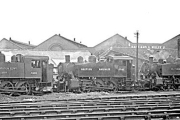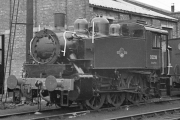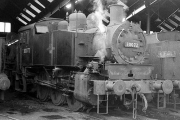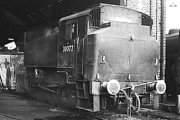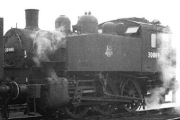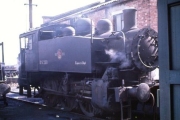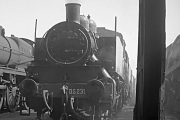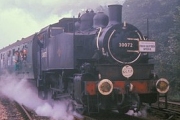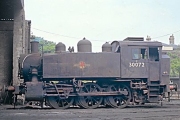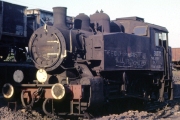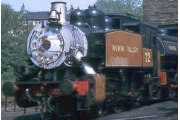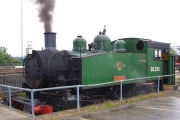Please be aware of our copyright notice. If you have a good reaon for using a photo from this site ask permission from first - it is frequently given.
U.S.A. 0-6-0T

photograph: Mike Morant collection
|
| These ungainly and very un-British looking locomotives came to
the Southern Railway, where they performed sterling service, as a result of
WWII.
In 1942 the United States Army Transportation Corps had these shunting tanks and the class S-160 2-8-0 heavy goods locomotives built by various American builders for use in post-invasion Europe. As these locomotives were shipped to England, some were stored and some used in the build up to D-Day. The 0-6-0 tanks were powerful and, due to their short coupled wheelbase, able to manoueuvre in tight areas. Southampton Docks had been well served by the Drummond B4 tanks for many years, supplemented by ex-LBSCR D1, then E1, tanks, but by the end of the war a number of new boilers were required. Prior to the war Eastleigh Works had quoted a figure of £865 per boiler but by 1945 this figure had inflated to £1,580 - plus an eighteen month delay! Because of this Bulleid was forced to look for a suitable replacement, and he found it amongst the dumped British and US War Department tanks. He rejected the former on account of their 11 foot wheelbase, inside cylinders and poor condition but found the US built locos in far better condition as few had actually been used since their trial runs, with one never having been steamed at all! They also had a 10 foot wheelbase and outside cylinders so on 29 April 1946 N°WD4326 (much later 30074) was taken into Eastleigh Works for attention. It ran trials at Southampton for several months after which it and 13 more were purchased, plus one more (WD1261) to be a source of spare parts. The operational locomotives became SR numbers 61-74, although 74 never carried its Southern Railway number as it ran as 4236 until November 1948. Prior to entering service such items as steam heating, vacuum ejectors, sliding cab windows, additional lamp irons and new cylinder drain cocks had to be added. In addition, a lot more modifications became necessary once the locomotives started to enter traffic. Large roof-top ventilators were fitted, British regulators (as built they had US-style pull-out ones), three rectangular cab-front lookout windows, extended coal bunkers (increasing capacity from 26cwt to 30cwt), separate steam and vacuum brake controls and wooden tip-up seats. Because of this it wasn't until November 1947 that they were all at work. Despite being sterling performers, the locomotives themselves deteriorated rapidly. Their wartime steel fireboxes in particular wore out rapidly, partly due to the hard water at Southampton, as a result of which several were either laid aside or restricted to light duties for a time from March 1951, their places being taken by the E1 class that they had themselves replaced! New steel fireboxes were eventually fitted whilst several had new cylinders provided, those on 30061 coming from the "spare" 1261 as late as November 1961 whilst the boiler from this loco had been fitted to 30063 in January 1951. From 1957 many of the class were fitted with radio telephones, turbo generators and aerials to enable more efficient use of them around the docks. Initially a very unpopular innovation with the loco crew, it became more accepted when they realized they were now able to remind control when their turn was coming to an end and a relief crew had to be provided! One was withdrawn and six were transferred to departmental stock in 1962, to be replaced by class 07 diesel shunters at Southampton, whilst the remainder were withdrawn between 1964 and 1967. Their successful use by the Southern Railway is also quoted as one of the reasons that Swindon "leaned" heavily on their design when developing the 15xx pannier tanks. |
Link to Railway Roundabout - Southampton Docks
|
Technical Details
| Introduced by SR: Driving Wheel: Length: Weight: Water Capacity: Cylinders (2): Boiler Pressure: Tractive Effort: Coal Capacity: Power Classification: |
December 1946 4 ft 6 ins 29 ft 8 ins 46 tons 10 cwt 1,200 US gals 16½ in x 24 in 210 lb sq in 21,600 lb 1 ton 10 cwt 3-F |
Data
| WD N° | Builder | Built | SR N° | BR N° | DS N° | In service | Final modification | To DS | Withdrawn |
| 1264 | Porter | 1942 | 61 | 30061 | DS233 | Nov 1947 | Nov 1947 | Oct 1962 | Mar 1967 |
| 1277 | Vulcan | 1942 | 62 | 30062 | DS234 | May 1947 | Sep 1948 | Dec 1962 | Mar 1967 |
| 1284 | Vulcan | 1942 | 63 | 30063 | - | Oct 1947 | Oct 1947 | - | May 1962 |
| 1959 | Vulcan | 1943 | 64 | s64 - 30064 | - | Jun 1947 | Jan 1948 | - | Jul 1967 |
| 1968 | Vulcan | 1943 | 65 | 30065 | DS237 | Nov 1947 | Nov 1947 | Nov 1963 | Sep 1967 |
| 1279 | Vulcan | 1942 | 66 | 30066 | DS235 | May 1947 | May 1948 | Mar 1963 | Aug 1965 |
| 1282 | Vulcan | 1942 | 67 | 30067 | - | May 1947 | Jun 1948 | - | Jul 1967 |
| 1971 | Vulcan | 1943 | 68 | 30068 | - | Oct 1947 | Oct 1947 | - | Mar 1964 |
| 1952 | Vulcan | 1943 | 69 | 30069 | - | Nov 1947 | Nov 1947 | - | Jul 1967 |
| 1960 | Vulcan | 1943 | 70 | 30070 | DS238 | Apr 1947 | Jan 1948 | Aug 1963 | Sep 1967 |
| 1966 | Vulcan | 1943 | 71 | 30071 | - | Nov 1947 | Nov 1947 | - | Jul 1967 |
| 1973 | Vulcan | 1943 | 72 | 30072 | - | Apr 1947 | Jul 1948 | - | Jul 1967 |
| 1974 | Vulcan | 1943 | 73 | s73 - 30073 | - | Jun 1947 | Mar 1948 | - | Dec 1966 |
| 4326 | Vulcan | 1943 | 74 # | 30074 | DS236 | May 1946 | Nov 1948 | Apr 1963 | Aug 1965 |
| 1261 | Porter | 1942 | ## | - | - | - | - | - | - |
| # ## |
Worked as 4326 from 18th May 1946 to 16th Oct 1948
and never carried SR number. Not taken into stock but was dismantled for spares. |
||||||||
This page was last updated 7 July 2020
